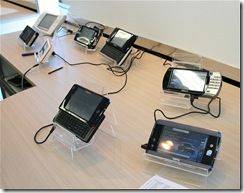Comprising the ‘system on chip’ known as Lincroft and the comms chip known as Langwell, the next-generation MID platform from Intel, known as Moorestown, promises to provide smaller sizes and smaller power consumption. At IDF in Taipei today, Intel demonstrated the first working version.
Chandrasekher said that Moorestown will be a catalyst for exciting and innovative developments that will extend the full Internet experience into the smartphone space with the Communication MID. He indicated that Moorestown platforms will support a range of wireless technologies including 3G, WiMAX, WiFi, GPS, Bluetooth and mobile TV. Additionally, Chandrasekher announced a collaboration with Ericsson* for HSPA data modules optimized for the Moorestown platform. He also announced that Option* is extending its collaboration for HSPA modules to the Moorestown platform. These 3G modules come in 25x30x2.x mm small size, are optimized for Moorestown power requirements and will help provide MID users with more powerful, always connected Internet-based experiences. [press release]
 Don’t expect too much information about Moorestown this week though as Intel have already stated that the next announcements are to come at the Spring IDF in 2009. In fact, if Menlow is anything to go by, the timeframe between first demonstrations and product availability will be about 18 months. We’ll keep an eye out for videos and details about Moorestown though.
Don’t expect too much information about Moorestown this week though as Intel have already stated that the next announcements are to come at the Spring IDF in 2009. In fact, if Menlow is anything to go by, the timeframe between first demonstrations and product availability will be about 18 months. We’ll keep an eye out for videos and details about Moorestown though.
Looking at the MID display from the technology showcase, I don’t see anything new there either. Keep any eye on the IDF photo stream at Flickr. Maybe something will turn up.











“Don’t expect too much information about Moorestown this week though as Intel have already stated that the next announcements are to come at the Spring IDF in 2009. In fact, if Menlow is anything to go by, the timeframe between first demonstrations and product availability will be about 18 months. We’ll keep an eye out for videos and details about Moorestown though.”
I’m going to try to be an optimist about this. Silverthorne was a very cheap way for Intel to test the waters for this market. Kinda a 1 size fits all chip for all the varieties of low power devices. Netbooks took off, and soaked up all the Si making MID’s not so easy to develop, and I think that was one of the reasons that they took so long to bring to market. Also, it’s rather hard to really cater to the MID market with the battery life #’s they’re sporting right now.
Lincroft is designed specifically for the handheld device segment, with other different chips for Nettop/Netbook’s and other segments. Because it’s focused towards only the MID/smartphone segment, and has huge gains in power effincy, I think the time to market may come down.
*shrug*
Intel was most keen to show us this prototype device at the Taipei Blogger Party . .
http://www.flickr.com/photos/huggerindustries/2953685337/in/pool-intelidf
Will spend more time with MIDs tomorrow; they ones we’re photo’d from the Tech Showcase are claiming 6 hour battery life.
Thanks DL. Was it actually a working sample?
The 6-hour battery life ones are probably the Viliv S5 and the Wibrain i1. I’m liking that Viliv a lot.
Steve.
Where is OQO Atom?
more info about moorestown:
http://www.tomshardware.com/news/Moorestown-Intel-MID,6513.html